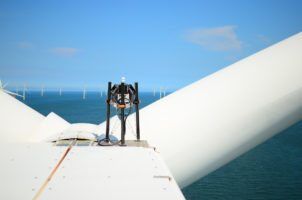

Energy
First Blade Leading Edge Erosion Measurement Campaign Delivered By Catapult
Possible increased revenue, as well as a significant increase in energy production, following the repair of moderate blade erosion.
The Offshore Renewable Energy (ORE) Catapult, in collaboration with Centrica, has successfully delivered the first in-field measurement campaign under its industry-leading blade leading edge programme (BLEEP), and concluded that an uplift in annual energy production (AEP) of between 1.5 to 2% is possible following the repair of moderate blade erosion.
The measurement campaign, carried out on behalf of ORE Catapult by the Measurement Services Department at RES, in collaboration with Centrica and focused on an offshore wind farm, used LiDAR technology to accurately measure the power performance impact of blade leading edge erosion by assessing performance before and after blade repairs were carried out.
The results will allow owner/operators to optimise their repair and maintenance strategies, balancing cost versus benefit in order to minimise levelised cost of energy impact and maximise revenue.
The resultant method will now be used to carry out a further two measurement campaigns as part of the wider collaborative industry programme of works, to validate the results and the methodology used.
Andrew Kay, ORE Catapult’s Innovation Manager, said: “Blade leading edge erosion remains a significant issue for the wind power industry. The outcomes from this project will help the industry to optimise blade maintenance informed by an understanding of both the cost and the benefit of repair work.
“However, this measurement represents a single result from a single turbine type, site, and level of erosion. As such it is extremely important that further studies are performed to build a more complete picture of how the level of erosion, site, turbine and atmospheric variables influence the impact of erosion on performance.
The methodology developed and executed as part of this campaign could also be used in the assessment of proactive turbine upgrades such as aerodynamic or control improvements as well as to assess the impact of leading edge protection products on power performance.
Bailey Bradley, Renewables Commercial Manager for Centrica, added: “Understanding and quantifying the impact of leading edge erosion on turbine performance is essential in order to manage the operating business, planning and forecasting and managing the OEM to help them to plan blade inspection and repair activities. ORE Catapult has brought operators together to participate in BLEEP, enabling the sector to share knowledge and reduce costs. It is often difficult for operators to share knowledge and data but ORE Catapult’s independence has enabled it to facilitate this and win the trust of the participants.”
Simon Feeney, Commercial Manager of the Measurement Services Department at RES said: “RES were delighted to support ORE Catapult in this groundbreaking innovative project. The ZephIR LiDAR technology selected for the measurement campaign, ZephIR DM, allowed small changes in the turbine performance to be detected and the full rotor measurement allowed us to isolate changes as a result of the blade repair from seasonal and diurnal shifts in performance. This first-of-a-kind campaign shows there is a real benefit to Annual Energy Production by taking a proactive approach to turbine maintenance”


 Environment9 months ago
Environment9 months agoAre Polymer Banknotes: an Eco-Friendly Trend or a Groundswell?

 Environment11 months ago
Environment11 months agoEco-Friendly Home Improvements: Top 7 Upgrades for 2025

 Features8 months ago
Features8 months agoEco-Friendly Cryptocurrencies: Sustainable Investment Choices

 Features9 months ago
Features9 months agoEco-Friendly Crypto Traders Must Find the Right Exchange





























